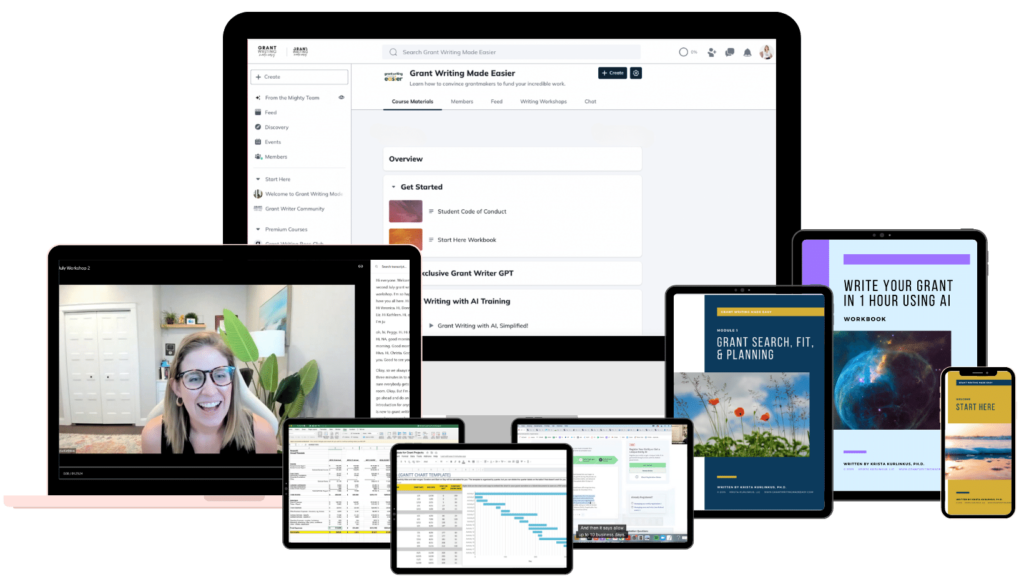If hearing about nonprofit budgets makes you cringe a little (or a lot), keep reading. We’ve got you.
In 2024, the grant landscape for nonprofits has evolved significantly, emphasizing the need for meticulous financial planning and transparent budgeting to meet funder expectations. Technology, especially AI, is crucial in enhancing budget accuracy and financial management, enabling more dynamic resource allocation. Moreover, the shifting investment perspectives within the grantmaking sector require nonprofits to adapt quickly, ensuring their budgeting strategies align with emerging funding models and opportunities
Based on insights from the latest annual Grant Professionals Association (GPA) report and current financial trends, this guide aims to equip nonprofit leaders with the tools and knowledge to craft effective budgets that support their mission and enhance their funding prospects.
The Importance of Budgets in 2024’s Nonprofit Sector
The nonprofit sector faces unique challenges and opportunities in 2024:
- Economic Uncertainty: Fluctuations in the global economy contribute to unpredictable funding streams, making financial sustainability a continuous challenge.
- Increasing Demand for Transparency: Funders and donors demand greater transparency in how funds are used, requiring nonprofits to maintain meticulous financial records and reporting.
- Adaptation to Technological Advances: With the rapid integration of technology such as AI in financial management, nonprofits must quickly adapt to utilize these tools effectively, which can be a barrier for organizations with limited tech expertise or resources.
- Regulatory Changes: Ongoing changes in government policies and regulations can affect funding, operations, and compliance, requiring constant vigilance and adaptability from nonprofit organizations.
- Competition for Funding: As more organizations vie for limited grants and donations, the competition intensifies, pushing nonprofits to differentiate themselves and prove their impact more convincingly than ever.
The need for precise and strategic budget planning cannot be overstated in the face of economic uncertainties and shifting donor expectations. As highlighted by the 2024 GPA report, a well-prepared budget is not just beneficial but essential for securing grants and sustaining operations. With the challenges of ongoing inflation and fluctuating funding streams, nonprofits must evolve their budgeting strategies to remain robust.
Emphasizing the importance of diversifying funding sources and crafting realistic revenue forecasts helps mitigate risks and ensure financial stability. For nonprofit managers, the capability to quickly adapt and respond to financial data is a critical skill in navigating the ever-changing landscape.
If you’re a brand new nonprofit organization this year, check out this blog to help you understand how to get started with funding as a nonprofit startup.
Comprehensive Steps to Developing Effective Nonprofit Budgets
Developing a robust nonprofit budget involves several steps but can be easily accomplished if you nail the foundational basics:
1. Review Historical Data
Reviewing historical data involves analyzing your organization’s past financial records to identify patterns in revenue and expenses. This helps in understanding financial stability and operational effectiveness over time.
Action Plan:
- Collect financial statements from the past 3-5 years, including income statements, balance sheets, and cash flow statements.
- Analyze these documents to identify trends, such as seasonal variations in income or recurring expenses.
- Use this analysis to inform your budget planning, helping predict future financial conditions more accurately.
2. Forecast Revenue and Expenses
Forecasting involves estimating future financial performance based on historical data and expected changes, such as new funding sources or planned projects. This step is crucial for setting realistic financial goals.
Action Plan:
- Utilize a free cash flow projector spreadsheet to help you visualize future cash inflows and outflows based on various scenarios.
- Enter estimated values for all known revenue streams and expenses for the upcoming period, adjusting for any anticipated changes or new initiatives.
- Review these projections regularly and adjust them as new financial information becomes available or as circumstances change.
3. Align Budgets with Strategic Goals
This step ensures that financial resources are allocated to support your organization’s long-term strategic objectives and immediate programmatic goals. It aligns financial planning with mission-critical activities.
Action Plan:
- Map out your organization’s strategic goals for the upcoming year or beyond.
- Design your budget to allocate resources towards these goals, ensuring that funding is available for key initiatives and projects.
- Communicate these alignments to stakeholders to justify budget decisions and highlight how financial resources are being used to advance the organizational mission.
4. Implement Regular Reviews
Regular budget reviews compared to actual financial performance allow for ongoing adjustments and optimization. This ensures that financial plans remain relevant and responsive to changes within and outside the organization.
Action Plan:
- Schedule monthly, quarterly, and annual review meetings with key financial and programmatic staff.
- During these meetings, compare projected budgets to actual expenses and revenues, discussing any variances.
- Adjust the budget as necessary to reflect changes in the organization’s financial landscape or strategic direction.
5. Prepare for Contingencies
Preparing for contingencies involves creating plans for potential financial downturns or unexpected expenses. This ensures the organization can continue operating effectively during financial crises.
Action Plan:
- Open a separate savings account specifically designated as a “rainy day” fund. Commit to depositing a set amount monthly, such as $5,000, based on your organization’s size and revenue.
- List all possible expenses that could be reduced or eliminated during financial stress. Prioritize essential services and programs that must be maintained.
- Calculate the number of months of operating costs available in reserve. Establish a clear plan for when to enact emergency measures (the “panic button”) if financial thresholds are breached.
By implementing these steps, your nonprofit can build a strong financial foundation that supports its mission while being prepared for unforeseen financial challenges.
For an in-depth exploration of each step and additional resources, join our Grant Writing Made Easier community. Here, you’ll find comprehensive guides, templates, and expert advice tailored specifically for nonprofits.
Understanding Nonprofit Operating and Program Budgets
Nonprofit budgets are generally categorized into two types, each serving a specific purpose within the organization: operating and program budgets.
Operating Budgets
Operating budgets are comprehensive financial outlines that encompass all the organizational income and expenditures. They offer a macro-level view of an organization’s financial health and are crucial for strategic planning and operational management.
Components:
- Revenue Sources: Includes diverse income streams such as donations, grants, membership fees, and earned income. Each source should be listed separately to track its performance against the budget.
- Fixed Costs: Regular expenses like rent, utilities, and salaries. These are predictable and generally consistent over time.
- Variable Costs: Expenses that fluctuate such as event costs, project-specific expenses, and marketing campaigns.
- One-time Expenses: These could include capital expenditures like purchasing equipment or property.
- Reserve Funds: Savings set aside for unexpected costs or financial downturns, demonstrating financial prudence to funders and stakeholders.
Creating an Operating Budget:
- Step 1: Gather Historical Data – Review past budgets and financial statements to understand spending patterns and revenue streams.
- Step 2: Forecast Revenue and Expenses – Use historical data and future projections to estimate incoming and outgoing funds.
- Step 3: Allocate Resources – Distribute funds across various departments and projects based on strategic priorities and past spending.
- Step 4: Review and Adjust – Regularly compare the projected budget to actual spending and adjust allocations as necessary to stay on target.
Program Budgets
Program budgets focus specifically on individual projects or programs within an organization. They are critical for grant applications as they demonstrate to funders how their contributions will be specifically utilized.
Components:
- Direct Costs: Expenses that are directly tied to the program, such as materials, staff salaries specific to the program, and direct operational costs.
- Indirect Costs: Overhead or administrative expenses that support the program but are not exclusive to it, like facility maintenance, utilities, and administrative staff salaries.
- Capital Costs: If applicable, costs associated with purchasing or upgrading physical assets for the program.
- Program Income: Any revenue generated directly from the program activities, such as fees for service or merchandise sales.
As practicing grant writing consultants ourselves, we know that the biggest hurdle to submitting grant applications is often crafting a comprehensive program budget. Here are our tips for making this easier for yourself and your team:
Creating a Program Budget:
- Step 1: Define Program Goals – Clearly outline the program’s goals and the resources needed.
- Step 2: Itemize Expenses – List all expected costs associated with the program. Ensure each cost is justified in terms of the program’s objectives.
- Step 3: Estimate Program Income – Project any income that will be generated directly from the program activities.
- Step 4: Monitor and Report – Track expenditures and income throughout the program duration and report these to funders as required.
Both types of budgets require meticulous preparation and ongoing management to ensure that they serve their respective purposes effectively. Operating budgets provide a bird’s-eye view of an organization’s financial health, which is essential for internal management and external stakeholders. In contrast, program budgets offer a detailed breakdown of costs and income for specific initiatives, crucial for securing and reporting on grant funding.
Leveraging Technology to Enhance Budget Accuracy
Integrating AI and advanced software into budget planning transforms how nonprofits forecast and manage their finances. In 2024, these tools will be invaluable for analyzing historical financial data, predicting future trends, and creating flexible budget models that can adapt to changing circumstances. For example, AI can assist in efficiently reallocating budget items when adjusting revenue projections or expense allocations.
We use AI in our grant writing and budget creation, particularly to develop budget line item ideas for new projects based on the project activities. We use AI for a lot of things!
If you want to learn more about how AI can help you with your grant writing, check out this blog post. If you’re ready to take a deep dive into leveraging the power of AI in your grant writing today, check out our AI course.
How Grant Writing Made Easier Will Help You Create Your Budgets

With 2024 bringing complex financial challenges, mastering budget preparation and management is vital for any nonprofit. Joining Grant Writing Made Easier provides access to special training in nonprofit financial management, including detailed budget templates and real-world examples that simplify the budgeting process.
Enroll in Grant Writing Made Easier today to leverage our expertly crafted courses and workshops designed to enhance your grant writing and nonprofit budgeting skills. You’ll gain the knowledge and tools necessary to develop budgets that appeal to funders and support your organization’s strategic goals.
Stay engaged with our blog for continuous updates, tips, and strategies to help you navigate the nonprofit financial landscape of 2024. Ready to Win More and Work Less? Explore our courses and resources in our comprehensive course, Grant Writing Made Easier.







Leave a Comment